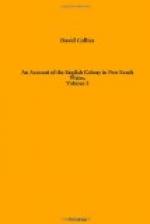In a house which stood upon the west side of the head, they found a net, or seine, about fourteen fathoms long, the meshes of which were much larger than any English seine, and the twine much stronger; but its depth was much less, being not more than three feet. At each end it had a pointed stick of about the same length. Upon the shoal near the house, there was more than one inclosure of a semicircular form, and the sticks and branches of which it was made were set and interwoven so close, that a fish could not pass between. This net Mr. Flinders supposed was to be placed diametrically across the semicircle at high water, and thus secure all the fish that might get within the inclosure, until the falling tide should leave them dry. He brought away the net, as a proof of the superior ingenuity of these over the natives of Port Jackson, leaving them in return a hatchet, the only present which he had to make them; and that they might the sooner learn the great use of their new acquisition, and be consoled for the loss of their net, he cut down some branches and laid them before the hut.
The wood, which at high water was collected for their fire, proved, when cut up, to be cedar, and of a fine grain. The remains of a canoe made of the stringy bark were lying upon the shore, near the house whence the net had been taken.
There were traces of dogs, kangaroos, and emus upon the beach. Two hawks of a moderate size were shot, but their plumage was unlike that of any known at Port Jackson. That which was the most remarkable was of an unvariegated dull red colour in the body, with a milk-white neck, breast, and head.
In the afternoon they made some further progress with the sloop, anchoring for the night on a soft muddy bottom.
On the following morning they got under weigh with a flood tide, and a moderate breeze from the northward. In their progress, they passed two islands, of from three to four miles each in circuit. The northernmost was the largest, and seemed well covered with wood, the greater part of which was probably mangrove, the island being nearly level with the water’s edge. The foliage of the trees upon the southern island was equally dark and luxuriant with this, but the interior part of it was higher. There were two other smaller islands, nearly on a level with the first, and covered with wood, but the southernmost was very small.
In passing between the two islands they had deep water; but on its suddenly shoaling they tacked and stood to the westward. In this situation the entrance from Moreton Bay was open, the south side of which bore N 68 degrees E six or eight miles, and the west side of what will now be Moreton Island bore N 2 degrees W. Another island. apparently larger than either of the four above mentioned, bore from the same place from S 55 degrees to 34 degrees E at the distance of about five miles. Reckoning the northernmost of the four islands to be the first in number, they made their course good for the third island, after tacking; and the water deepened almost immediately to six fathoms.




